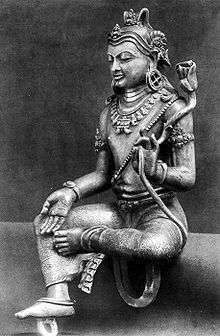Bodhisattva
In Buddhism, a bodhisattva (/ˌboʊdiːˈsʌtvə/ BOH-dee-SUT-və)[1] is any person who is on the path towards Buddhahood.
| Bodhisattva | |
|---|---|
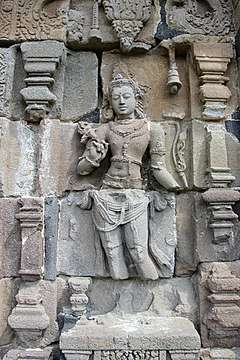 | |
| Sanskrit | बोधिसत्त्व (Bodhisattva) |
| Pāli | बोधिसत्त (Bodhisatta) |
| Burmese | ဗောဓိသတ်) (bɔ́dḭθaʔ) |
| Chinese | 菩提薩埵(菩薩), 菩提萨埵(菩萨), (pútísàduǒ (púsà) ), (Wade–Giles: p'u2-sa4), (Jyutping: pou4 tai4 saat3 do3) |
| Japanese | 菩薩 (romaji: bosatsu) |
| Khmer | ពោធិសត្វ (Pothisat) |
| Korean | 보살, 菩薩 (RR: bosal) |
| Thai | โพธิสัตว์ (phothisat) |
| Tibetan | བྱང་ཆུབ་སེམས་དཔའ་ (chang chub sems dpa) |
| Vietnamese | Bồ Tát 菩薩 |
| Information | |
| Venerated by | Mahāyāna, Vajrayāna |
| Part of a series on |
| Buddhism |
|---|
 |
|
|
|
In the Early Buddhist schools as well as modern Theravada Buddhism, a bodhisattva (Pali: bodhisatta) refers to anyone who has made a resolution to become a Buddha and has also received a confirmation or prediction from a living Buddha that this will be so.[2]
In Mahayana Buddhism, a bodhisattva refers to anyone who has generated bodhicitta, a spontaneous wish and compassionate mind to attain Buddhahood for the benefit of all sentient beings.[3]
The elaborate concept refers to a sentient being or sattva that develops bodhi or enlightenment — thus possessing the boddisattva's psyche; described as those who works to develop and exemplify the loving-kindness (metta), compassion (karuṇā), empathetic joy (mudita) and equanimity (upekkha). These four virtues are the four divine abodes, called Brahmavihara (illimitables).[4]
Early Buddhism and the Nikāya schools
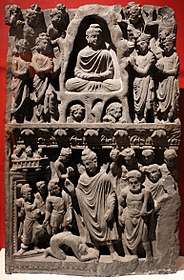
In early Buddhism, the term bodhisattva is used in the early texts to refer to Gautama Buddha in his previous lives[5] and as a young man in his current life in the period during which he was working towards his own liberation. During his discourses, to recount his experiences as a young aspirant he regularly uses the phrase "When I was an unenlightened bodhisatta..." The term therefore connotes a being who is "bound for enlightenment", in other words, a person whose aim is to become fully enlightened. In the Pāli canon, the bodhisatta (bodhisattva) is also described as someone who is still subject to birth, illness, death, sorrow, defilement, and delusion. Some of the previous lives of the Buddha as a bodhisattva are featured in the Jataka tales.
According to the Theravāda monk Bhikkhu Bodhi, the bodhisattva path is not taught in the earliest strata of Buddhist texts such as the Pali Nikayas (and their counterparts such as the Chinese Āgamas) which instead focus on the ideal of the Arahant.[6]
The oldest known story about how Gautama Buddha becomes a bodhisattva is the story of his encounter with the previous Buddha, Dīpankara. During this encounter, a previous incarnation of Gautama, variously named Sumedha, Megha, or Sumati offers five blue lotuses and spreads out his hair or entire body for Dīpankara to walk on, resolving to one day become a Buddha. Dīpankara then confirms that they will attain Buddhahood.[2] Early Buddhist authors saw this story as indicating that the making of a resolution (abhinīhāra) in the presence of a living Buddha and his prediction/confirmation of one's future Buddhahood was necessary to become a bodhisattva. According to Drewes, "all known models of the path to Buddhahood developed from this basic understanding."[2]
The path is explained differently by the various Nikaya schools. In the Theravāda Buddhavaṃsa (1st-2nd century BCE), after receiving the prediction, Gautama took four asaṃkheyyas ("incalculable aeons") and a hundred thousand, shorter kalpas (aeons) to reach Buddhahood.[2]
The Sarvāstivāda school had similar models about how the Buddha Gautama became a bodhisattva. They held it took him three asaṃkhyeyas and ninety one kalpas (aeons) to become a Buddha after his resolution (praṇidhāna) in front of a past Buddha. During the first asaṃkhyeya he is said to have encountered and served 75,000 Buddhas, and 76,000 in the second, after which he received his first prediction (vyākaraṇa) of future Buddhahood from Dīpankara, meaning that he could no longer fall back from the path to Buddhahood.[2] Thus, the presence of a living Buddha is also necessary for Sarvāstivāda. The Mahāvibhāṣā explains that its discussion of the bodhisattva path is partly meant "to stop those who are in fact not bodhisattvas from giving rise to the self-conceit that they are."[2]
The Mahāvastu of the Mahāsāṃghika-Lokottaravādins presents four stages of the bodhisattva path without giving specific time frames (though its said to take various asaṃkhyeya kalpas):[2]
- Natural (prakṛti), one first plants the roots of merit in front of a Buddha to attain Buddhahood.
- Resolution (praṇidhāna), one makes their first resolution to attain Buddhahood in the presence of a Buddha.
- Continuing (anuloma), one continues to practice until one meets a Buddha who confirms one's future Buddhahood.
- Irreversible (anivartana), at this stage, one cannot fall back.
Later Theravāda
The Sri Lankan commentator Dhammapala in his commentary on the Cariyāpiṭaka, a text which focuses on the bodhisattva path, notes that to become a bodhisattva one must make a valid resolution in front of a living Buddha, which confirms that one is irreversible (anivattana) from the attainment of Buddhahood. The Nidānakathā, as well as the Buddhavaṃsa and Cariyāpiṭaka commentaries makes this explicit by stating that one cannot use a substitute (such as a Bodhi tree, Buddha statue or Stupa) for the presence of a living Buddha, since only a Buddha has the knowledge for making a reliable prediction. This is the generally accepted view maintained in orthodox Theravada today.[2] The idea is that any resolution to attain Buddhahood may easily be forgotten or abandoned during the aeons ahead. The Burmese monk Ledi Sayadaw (1846–1923) explains that though it is easy to make vows for future Buddhahood by oneself, it is very difficult to maintain the necessary conduct and views during periods when the Dharma has disappeared from the world. One will easily fall back during such periods and this is why one is not truly a full bodhisattva until one receives recognition from a living Buddha.[2]
Because of this, it was and remains a common practice in Theravada to attempt to establish the necessary conditions to meet the future Buddha Maitreya and thus receive a prediction from him. Medieval Theravada literature and inscriptions report the aspirations of monks, kings and ministers to meet Maitreya for this purpose. Modern figures such as Anagarika Dharmapala (1864–1933), and U Nu (1907–1995) both sought to receive a prediction from a Buddha in the future and believed meritorious actions done for the good of Buddhism would help in their endeavor to become bodhisattvas in the future.[2]
Over time the term came to be applied to other figures besides Gautama Buddha in Theravada lands, possibly due to the influence of Mahayana. The Theravada Abhayagiri tradition of Sri Lanka practiced Mahayana Buddhism and was very influential until the 12th century.[8] Kings of Sri Lanka were often described as bodhisattvas, starting at least as early as Sirisanghabodhi (r. 247–249), who was renowned for his compassion, took vows for the welfare of the citizens, and was regarded as a mahāsatta (Sanskrit mahāsattva), an epithet used almost exclusively in Mahayana Buddhism.[9] Many other Sri Lankan kings from the 3rd until the 15th century were also described as bodhisattvas and their royal duties were sometimes clearly associated with the practice of the Ten Pāramitās.[10] In some cases, they explicitly claimed to have received predictions of Buddhahood in past lives.[2]

Theravadin bhikkhu and scholar Walpola Rahula stated that the bodhisattva ideal has traditionally been held to be higher than the state of a śrāvaka not only in Mahayana but also in Theravada Buddhism. He also quotes the 10th century king of Sri Lanka, Mahinda IV (956–972 CE), who had the words inscribed "none but the bodhisattvas will become kings of a prosperous Lanka," among other examples.[11]
But the fact is that both the Theravada and the Mahayana unanimously accept the Bodhisattva ideal as the highest...Although the Theravada holds that anybody can be a Bodhisattva, it does not stipulate or insist that all must be Bodhisattva which is considered not practical.
— Walpola Rahula, Bodhisattva Ideal in Buddhism[12]
Jeffrey Samuels echoes this perspective, noting that while in Mahayana Buddhism the bodhisattva path is held to be universal and for everyone, in Theravada it is "reserved for and appropriated by certain exceptional people."[13] Paul Williams writes that some modern Theravada meditation masters in Thailand are popularly regarded as bodhisattvas.[14]
In Mahāyāna Buddhism
Early Mahāyāna
Mahāyāna Buddhism (often also called Bodhisattvayāna, or the "Bodhisattva Vehicle") is based principally upon the path of a bodhisattva.[15] This path was seen as nobler than becoming an arhat or a solitary Buddha. According to David Drewes, "Mahayana sutras unanimously depict the path beginning with the first arising of the thought of becoming a Buddha (prathamacittotpāda), or the initial arising of bodhicitta, typically aeons before one first receives a Buddha’s prediction, and apply the term bodhisattva from this point."[2]
The Aṣṭasāhasrikā Prajñāpāramitā Sūtra, one of the earliest known Mahayana texts, contains a simple and brief definition for the term bodhisattva, which is also the earliest known Mahāyāna definition.[16][17] This definition is given as the following: "Because he has bodhi as his aim, a bodhisattva-mahāsattva is so called."[18]
The Aṣṭasāhasrikā, also divides the path into three stages. The first stage is that of bodhisattvas who “first set out in the vehicle” (prathamayānasaṃprasthita), then there is the “irreversible” (avinivartanīya) stage, and finally the third “bound by one more birth” (ekajātipratibaddha), as in, destined to become a Buddha in the next life.[2] Drewes also notes that:
When Mahāyāna sūtras present stories of Buddhas and bodhisattvas’ first arising of the thought of attaining Buddhahood, they invariably depict it as taking place in the presence of a Buddha, suggesting that they shared with all known nikāya traditions the understanding that this is a necessary condition for entering the path. In addition, though this key fact is often obscured in scholarship, they apparently never encourage anyone to become a bodhisattva or present any ritual or other means of doing so. Like nikāya texts, they also regard the status of new or recent bodhisattvas as largely meaningless. The Aṣṭasāhasrikā, for instance, states that as many bodhisattvas as there grains of sand in the Ganges turn back from the pursuit of Buddhahood and that out of innumerable beings who give rise to bodhicitta and progress toward Buddhahood, only one or two will reach the point of becoming irreversible.[2]

Drewes also adds that early texts like the Aṣṭasāhasrikā treat bodhisattvas who are beginners (ādikarmika) or "not long set out in the [great] vehicle" with scorn, describing them as "blind", "unintelligent", "lazy" and "weak". Early Mahayana works identify them with those who reject Mahayana or who abandon Mahayana, and they are seen as likely to become śrāvakas (those on the arhat path). Rather than encouraging them to become bodhisattvas, what early Mahayana sutras like the Aṣṭa do is to help individuals determine if they have already received a prediction in a past life, or if they are close to this point.[2] The Aṣṭa provides a variety of methods, including forms of ritual or divination, methods dealing with dreams and various tests, especially tests based on one's reaction to the hearing of the content in the Aṣṭasāhasrikā itself. The text states that encountering and accepting its teachings mean one is close to being given a prediction and that if one does not "shrink back, cower or despair" from the text, but "firmly believes it", one is irreversible. Many other Mahayana sutras such as the Akṣobhyavyūha and the Śūraṃgamasamādhi Sūtra present textual approaches to determine one's status as an advanced bodhisattva. These mainly consist in one's attitude towards listening to, believing, preaching, proclaiming, copying or memorizing and reciting the sutra.[2] According to Drewes, this claim that merely having faith in Mahāyāna sūtras meant that one was an advanced bodhisattva, was a departure from previous Nikaya views about bodhisattvas. It created new groups of Buddhists who accepted each other's bodhisattva status.[2]
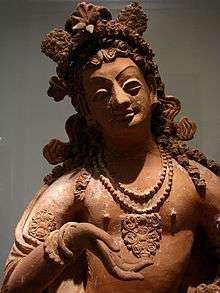
Some of early depictions of the Bodhisattva path in texts such as the Ugraparipṛcchā Sūtra describe it as an arduous, difficult monastic path suited only for the few which is nevertheless the most glorious path one can take. Three kinds of bodhisattvas are mentioned: the forest, city, and monastery bodhisattvas—with forest dwelling being promoted a superior, even necessary path in sutras such as the Ugraparipṛcchā and the Samadhiraja sutras.[19] The early Rastrapalapariprccha sutra also promotes a solitary life of meditation in the forests, far away from the distractions of the householder life. The Rastrapala is also highly critical of monks living in monasteries and in cities who are seen as not practicing meditation and morality.[20] The Ratnagunasamcayagatha also says the bodhisattva should undertake ascetic practices (dhutanga), "wander freely without a home", practice the paramitas and train under a guru in order to perfect his meditation practice and realization of prajñaparamita.[21] Some scholars have used these texts to argue for "the forest hypothesis", the theory that the initial Bodhisattva ideal was associated with a strict forest asceticism. But other scholars point out that many other Mahayana sutras do not promote this ideal, focusing on sutra based practices.[22]
Some Mahayana sutras promoted another revolutionary doctrinal turn, claiming that the three vehicles of the Śrāvakayāna, Pratyekabuddhayāna and the Bodhisattvayāna were really just one vehicle (ekayana). This is most famously promoted in the Lotus Sūtra which claims that the very idea of three separate vehicles is just an upaya, a skillful device invented by the Buddha to get beings of various abilities on the path. But ultimately, it will be revealed to them that there is only one vehicle, the ekayana, which ends in Buddhahood.[23]
Mature Mahāyāna

Over time, Mahayana Buddhists developed mature systematized doctrines about the bodhisattva path. The authors of the various Madhyamaka shastras (treatises) often presented the view of the ekayana. The texts and sutras associated with the Yogacara school developed a different theory of three separate gotras or lineages, that inherently predisposed a person to either the vehicle of the arhat, pratyekabuddha or samyak-saṃbuddha (fully self awakened one).[22] However, the term was also used in a broader sense. According to the eight century Mahāyāna philosopher Haribhadra, the term "bodhisattva" can refer to those who follow any of the three vehicles, since all are working towards bodhi (awakening). Therefore, the specific term for a Mahāyāna bodhisattva is a mahāsattva (great being) bodhisattva.[24] According to Atiśa's 11th century Bodhipathapradīpa, the central defining feature of a Mahāyāna bodhisattva is the universal aspiration to end suffering for all sentient beings, which is termed bodhicitta (the heart set on awakening).[25] Later Sanskrit Mahayana Buddhists also developed specific rituals and devotional acts for the arising of this absolutely central quality of bodhicitta, such as the "seven part worship" (Saptāṇgapūjā or Saptavidhā Anuttarapūjā). This ritual form is visible in the works of Shantideva (8th century) and includes:[26]
- Vandana (obeisance, bowing down)
- Puja (worship of the Buddhas)
- Sarana-gamana (going for refuge)
- Papadesana (confession of bad deeds)
- Punyanumodana (rejoicing in merit of the good deeds of oneself and others)
- Adhyesana (prayer, entreaty) and yacana (supplication) – request to Buddhas and Bodhisattvas to continue preaching Dharma
- Atmabhavadi-parityagah (surrender)

Contemporary Mahāyāna Buddhism follows this model and encourages everyone to give rise to bodhicitta and ceremonially take bodhisattva vows. With these vows, one makes the promise to work for the complete enlightenment of all sentient beings by practicing the transcendent virtues or paramitas.[27]
Related to the different views on the different types of yanas or vehicles is the question of a bodhisattva's relationship to nirvāṇa. In the various Mahāyāna texts, two theories can be discerned. One view is the idea that a bodhisattva must postpone their awakening until full Buddhahood is attained (at which point one ceases to be reborn, which is the classical view of nirvāṇa). This view is promoted in some sutras like the Pañcavimsatisahasrika-prajñaparamita-sutra.[28] The second theory is the idea that there are two kinds of nirvāṇa, the nirvāṇa of an arhat and a superior type of nirvāṇa called apratiṣṭhita (non-abiding) that allows a Buddha to remain engaged in the world. This doctrine developed in Yogacara. As noted by Paul Williams, the idea of apratiṣṭhita nirvāṇa may have taken some time to develop and is not obvious in some of the early Mahāyāna literature, therefore while earlier sutras may sometimes speak of "postponement", later texts saw no need to postpone the "superior" apratiṣṭhita nirvāṇa.[28]
In this Yogacara model, the bodhisattva definitely rejects and avoids the liberation of the śravaka and pratyekabuddha, described in Mahāyāna literature as either inferior or "Hina" (as in Asaṅga's fourth century Yogācārabhūmi) or as ultimately false or illusory (as in the Lotus Sūtra).[29] That a bodhisattva has the option to pursue such a lesser path, but instead chooses the long path towards Buddhahood is one of the five criteria for one to be considered a bodhisattva. The other four are: being human, being a man, making a vow to become a Buddha in the presence of a previous Buddha, and receiving a prophecy from that Buddha.
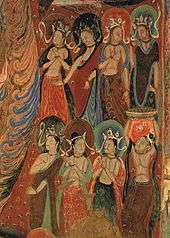
Over time, a more varied analysis of bodhisattva careers developed focused on one's motivation. This can be seen in the Tibetan Buddhist teaching on three types of motivation for generating bodhicitta. According to Patrul Rinpoche's 19th century Words of My Perfect Teacher (Kun bzang bla ma'i gzhal lung), a bodhisattva might be motivated in one of three ways. They are:
- King-like bodhicitta – To aspire to become a Buddha first in order to then help sentient beings.
- Boatman-like bodhicitta – To aspire to become a Buddha at the same time as other sentient beings.
- Shepherd-like bodhicitta – To aspire to become a Buddha only after all other sentient beings have done so.
These three are not types of people, but rather types of motivation. According to Patrul Rinpoche, the third quality of intention is most noble though the mode by which Buddhahood occurs is the first; that is, it is only possible to teach others the path to enlightenment once one has attained enlightenment oneself.[30] The ritualized formulation of the bodhisattva vow also reflects this order (becoming a buddha so that one can then teach others to do the same). A bodhisattva vow ritual text attributed to Nāgārjuna, of the second-third century CE, states the vow as follows: "Just as the past tathāgata arhat samyaksambuddhas, when engaging in the behavior of a bodhisattva, generated the aspiration to unsurpassed complete enlightenment so that all beings be liberated, all beings be freed, all beings be relieved, all beings attain complete nirvana, all beings be placed in omniscient wisdom, in the same way, I whose name is so-and-so, from this time forward, generate the aspiration to unsurpassed complete enlightenment so that all beings be liberated, all beings be freed, all beings be relieved, all beings attain complete nirvana, all beings be placed in omniscient wisdom."[31]
The six perfections that constitute bodhisattva practice should not be confused with the acts of benefiting beings that the bodhisattva vows to accomplish once he or she is a buddha. The six perfections are a mental transformation and need not benefit anyone. This is seen in the story of Vessantara, an incarnation of Śākyamuni Buddha while he was still a bodhisattva, who commits the ultimate act of generosity by giving away his children to an evil man who mistreats them. Vessantara's generous act causes indirect harm, however, the merit from the perfection of his generosity fructifies when he attains complete enlightenment as Śākyamuni Buddha.[32]
Bodhisattva grounds or levels

According to many traditions within Mahāyāna Buddhism, on the way to becoming a Buddha, a bodhisattva proceeds through ten, or sometimes fourteen, grounds or bhūmis. Below is the list of the ten bhūmis and their descriptions according to the Avataṃsaka Sūtra and The Jewel Ornament of Liberation, a treatise by Gampopa, an influential teacher of the Tibetan Kagyu school. (Other schools give slightly variant descriptions.)
Before a bodhisattva arrives at the first ground, he or she first must travel the first two of five paths:
- the path of accumulation
- the path of preparation
The ten grounds of the bodhisattva then can be grouped into the next three paths:
- bhūmi 1 the path of insight
- bhūmis 2–7 the path of meditation
- bhūmis 8–10 the path of no more learning
The chapter of ten grounds in the Avataṃsaka Sūtra refers to 52 stages. The 10 grounds are:
- Great Joy: It is said that being close to enlightenment and seeing the benefit for all sentient beings, one achieves great joy, hence the name. In this bhūmi the bodhisattvas practice all perfections (pāramitās), but especially emphasizing generosity (dāna).
- Stainless: In accomplishing the second bhūmi, the bodhisattva is free from the stains of immorality, therefore, this bhūmi is named "stainless". The emphasized perfection is moral discipline (śīla).
- Luminous: The light of Dharma is said to radiate for others from the bodhisattva who accomplishes the third bhūmi. The emphasized perfection is patience (kṣānti).
- Radiant: This bhūmi it is said to be like a radiating light that fully burns that which opposes enlightenment. The emphasized perfection is vigor (vīrya).
- Very difficult to train: Bodhisattvas who attain this ground strive to help sentient beings attain maturity, and do not become emotionally involved when such beings respond negatively, both of which are difficult to do. The emphasized perfection is meditative concentration (dhyāna).
- Obviously Transcendent: By depending on the perfection of wisdom, [the bodhisattva] does not abide in either saṃsāra or nirvāṇa, so this state is "obviously transcendent". The emphasized perfection is wisdom (prajñā).
- Gone afar: Particular emphasis is on the perfection of skillful means (upāya), to help others.
- Immovable: The emphasized virtue is aspiration. This "immovable" bhūmi is where one becomes able to choose his place of rebirth.
- Good Discriminating Wisdom: The emphasized virtue is the understanding of self and non-self.
- Cloud of Dharma: The emphasized virtue is the practice of primordial wisdom.
After the ten bhūmis, according to Mahāyāna Buddhism, one attains complete enlightenment and becomes a Buddha.
With the 52 stages, the Śūraṅgama Sūtra recognizes 57 stages. With the 10 grounds, various Vajrayāna schools recognize 3–10 additional grounds, mostly 6 more grounds with variant descriptions.[33][34]
A bodhisattva above the 7th ground is called a mahāsattva. Some bodhisattvas such as Samantabhadra are also said to have already attained buddhahood.[35]
School doctrines
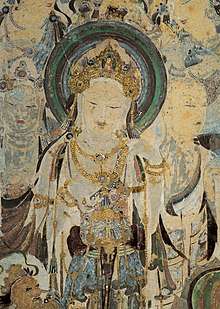
Some sutras said a beginner would take 3–22 countless eons (mahāsaṃkhyeya kalpas) to become a buddha.[36][37][38] Pure Land Buddhism suggests buddhists go to the pure lands to practice as bodhisattvas. Tiantai, Huayan, Zen and Vajrayāna schools say they teach ways to attain buddhahood within one karmic cycle.[39][40]
Various traditions within Buddhism believe in specific bodhisattvas. Some bodhisattvas appear across traditions, but due to language barriers may be seen as separate entities. For example, Tibetan Buddhists believe in various forms of Chenrezig, who is Avalokiteśvara in Sanskrit, Guanyin in China, Gwan-eum in Korea, Quan Am in Vietnam, and Kannon in Japan. Followers of Tibetan Buddhism consider the Dalai Lamas and the Karmapas to be an emanation of Chenrezig, the Bodhisattva of Compassion.
The place of a bodhisattva's earthly deeds, such as the achievement of enlightenment or the acts of Dharma, is known as a bodhimaṇḍa, and may be a site of pilgrimage. Many temples and monasteries are famous as bodhimaṇḍas. Perhaps the most famous bodhimaṇḍa of all is the Bodhi Tree under which Śākyamuṇi achieved buddhahood. In the tradition of Chinese Buddhism, there are four mountains that are regarded as bodhimaṇḍas for bodhisattvas, with each site having major monasteries and being popular for pilgrimages by both monastics and laypeople. These four bodhimandas are:
- Mount Putuo: Avalokiteśvara, Bodhisattva of Compassion (Chinese: 觀自在菩薩, 觀世音菩薩, 觀音菩薩; pinyin: Guānzìzài Púsà, Guānshìyīn Púsà, Guānyīn Púsà)
- Mount Emei: Samantabhadra, Bodhisattva of Practice (Chinese: 普賢菩薩 普贤菩萨; pinyin: Pǔxián Púsà)
- Mount Wutai: Mañjuśrī, Bodhisattva of Wisdom (Chinese: 文殊菩薩, 文殊师利菩薩, 曼殊室利菩薩, 妙吉祥菩薩; pinyin: Wénshū Púsà, Wénshūshīlì Púsà, Mànshūshìlì Púsà, Miàojíxiáng Púsà)
- Mount Jiuhua: Kṣitigarbha, Bodhisattva of the Great Vow (Chinese: 地藏菩薩 地藏菩萨; pinyin: Dìzàng Púsà)
Iconography and the popular mind
In Buddhist art, a bodhisattva is often described as a beautiful figure, most often personified as a youthful prince with serene expression and graceful manner. This is probably in accordance to the description of Prince Siddhārtha Gautama as a bodhisattva. The depiction of bodhisattva in Buddhist art around the world aspire to express the bodhisattva's quality; loving-kindness (metta), compassion (karuna), empathetic joy (mudita) and equanimity (upekkha).[4]
Gender variant representations of some bodhisattvas, most notably Avalokiteśvara, has prompted conversation regarding the nature of a bodhisattva's appearance. Chan master Sheng Yen has stated that Mahāsattvas such as Avalokiteśvara (known as Guanyin in Chinese) are androgynous (Ch. 中性; pinyin: "zhōngxìng"), which accounts for their ability to manifest in masculine and feminine forms of various degrees.[41]
While bodhisattvas tend to be depicted as conventionally beautiful, there are instances of their manifestation as wrathful and monstrous beings. A notable example is Guanyin's manifestation as a preta named "Flaming Face" (面燃大士).[42] This trope is commonly employed among the Wisdom Kings, among whom Mahāmāyūrī Vidyārājñī stands out with a feminine title and benevolent expression. In some depictions, her mount takes on a wrathful appearance. This variation is also found among images of Vajrapani.
Gallery
_(5424601351).jpg) Standing bodhisattva. Gandhāra, 2nd–3rd century.
Standing bodhisattva. Gandhāra, 2nd–3rd century. Standing bodhisattva. Gandhāra, 2nd–3rd century.
Standing bodhisattva. Gandhāra, 2nd–3rd century.
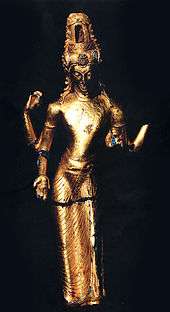 The golden Srivijayan Bodhisattva Avalokiteśvara, Muarabulian, Jambi, Indonesia c. 11th century.
The golden Srivijayan Bodhisattva Avalokiteśvara, Muarabulian, Jambi, Indonesia c. 11th century.
See also
- Bodhicharyavatara (A Guide to the Bodhisattva Way of Life)
- Bodhisattvas of the Earth
- Bodhisattva vows
- Buddhist holidays
- Junzi
- Karuna (compassion in Sanskrit)
- List of bodhisattvas
- Vegetarianism in Buddhism
Citations
- "Bodhisattva". Collins English Dictionary.
- Drewes, David, Mahāyāna Sūtras and Opening of the Bodhisattva Path, Paper presented at the XVIII the IABS Congress, Toronto 2017, Updated 2019.
- The Bodhisattva Vow: A Practical Guide to Helping Others, page 1, Tharpa Publications (2nd. ed., 1995) ISBN 978-0-948006-50-0
- Flanagan, Owen (2011-08-12). The Bodhisattva's Brain: Buddhism Naturalized. MIT Press. p. 107. ISBN 978-0-262-29723-3.
- Basham, A.L. (1981). The evolution of the concept of the bodhisattva. In: Leslie S Kawamura, The bodhisattva doctrine in Buddhism, Published for the Canadian Corporation for Studies in Religion by Wilfrid Laurier University Press, p. 19
- "Arahants, Bodhisattvas and Buddhas".
- "The crossroads of Asia", edited by Ellizabeth Errington and Joe Cribb, The ancient India and Iran Trust, 1992, ISBN 0951839918, pp. 189–190
- Hoiberg, Dale H., ed. (2010). "Abhayagiri". Encyclopædia Britannica. I: A–ak Bayes (15th ed.). Chicago, Illinois: Encyclopædia Britannica Inc. p. 30. ISBN 978-1-59339-837-8.
- Holt, John. Buddha in the Crown : Avalokitesvara in the Buddhist Traditions of Sri Lanka. 1991. p. 59
- Holt, John. Buddha in the Crown : Avalokitesvara in the Buddhist Traditions of Sri Lanka. 1991. pp. 59–60
- Holt, John. Buddha in the Crown : Avalokitesvara in the Buddhist Traditions of Sri Lanka. 1991. p. 60
- Rahula, Walpola. "Bodhisattva Ideal in Buddhism (from Gems of Buddhist Wisdom)". Buddhist Missionary Society, 1996.
- Samuels, J. THE BODHISATTVA IDEAL IN THERAVAADA, BUDDHIST THEORY AND PRACTICE: A REEVALUATION OF THE BODHISATTVA-`SRAAVAKA OPPOSITION; Philosophy East and West Volume 47, Number 3 July 1997 pp. 399–415, University of Hawai'i Press
- Williams, Paul. Mahāyāna Buddhism: The Doctrinal Foundations. Taylor & Francis, 1989, p. 328.
- Nattier, Jan (2003), A few good men: the Bodhisattva path according to the Inquiry of Ugra: p. 174
- Mall, Linnart. Studies in the Astasahasrika Prajnaparamita and Other Essays. Motilal Banarsidass. 2005. pp. 53–54.
- Hirakawa, Akira. A history of Indian Buddhism: from Śākyamuni to Early Mahāyāna. Motilal Banarsidass. 2007. p. 297.
- Conze, Edward. The Perfection of Wisdom in Eight Thousand Lines and its Verse Summary. Grey Fox Press. 2001. p. 89.
- Ray, Reginald. Buddhist saints in India, p. 252.
- Ray, Reginald. Buddhist saints in India, p. 265.
- Ray, Reginald. Buddhist saints in India, p. 255.
- Drewes, David, Early Indian Mahayana Buddhism II: New Perspectives, Religion Compass 4/2 (2010): 66–74, doi:10.1111/j.1749-8171.2009.00193.x
- Silk, Jonathan; Hinüber, Oskar von; Eltschinger, Vincent; eds. (2016). "Lotus Sutra", in Brill's Encyclopedia of Buddhism, Volume 1: Literature and Languages. Leiden: Brill. p. 147
- Williams, Paul, Mahayana Buddhism: The Doctrinal Foundations, Routledge, 2008, p. 55.
- Williams, Paul, Mahayana Buddhism: The Doctrinal Foundations, Routledge, 2008, pp. 195–196.
- Har Dayal, The Bodhisattva Doctrine in Buddhist Sanskrit Literature, Motilal Banarsidass Publ., 1999, p. 54.
- The Bodhisattva Vow: A Practical Guide to Helping Others, pp. 4–12, Tharpa Publications (2nd. ed., 1995) ISBN 978-0-948006-50-0
- Williams, Paul, Mahayana Buddhism: The Doctrinal Foundations, Routledge, 2008, pp. 59–60.
- "bodhisattva" In The Princeton Dictionary of Buddhism (Princeton: Princeton University Press, 2013), 135.
- Words of My Perfect Teacher: A Complete Translation of A Classic Introduction to Tibetan Buddhism. Translated by The Padmakara Translation Group. (Walnut Creek: Altamira, 1994), 218.
- Nagārjuna. Byang chub mchog tu sems bskyed pa'i cho ga (Bodhicittotpadaviddhi, Ritual for Generating the Intention for Supreme Buddhahood). Toh. 3966 Tengyur, mdo, gi. (sems can thams cad bsgral ba dang/ sems can thams cad dgrol ba dang/ sems can thams cad dbugs dbyung ba dang/ sems can thams cad yongs su mya ngan las 'da' ba dang/ sems can thams cad thams cad mkhyen pa'i ye shes la dgod pa'i slad du ci ltar bla na med pa yang dag par rdzogs pa'i byang chub tu thugs bskyed pa de bzhin du bdag ming 'di zhes bgyi ba yang dus 'di nas bzung)
- "Vessantara" In The Princeton Dictionary of Buddhism (Princeton: Princeton University Press, 2013), 965.
- "大圆满心性休息 – 显密文库 佛教文集". Archived from the original on 8 September 2015. Retrieved 21 August 2015.
- 鄔金旺度. "吉祥鄔金密嚴寺". Retrieved 21 August 2015.
- 459 因地菩薩和果地菩薩
- 三大阿僧祇劫 Archived November 21, 2008, at the Wayback Machine
- 成佛的目的是到每 – 個世界去度眾生. Archived April 11, 2009, at the Wayback Machine
- 即身成就與三大阿僧祇劫之修行 Archived May 26, 2013, at the Wayback Machine
- "顯教與密教". Archived from the original on 11 September 2011. Retrieved 21 August 2015.
- 「無諍之辯」導讀
- Sheng Yen. "圣严法师《观世音菩萨的性别》". 佛弟子文库. Retrieved 2019-08-30.
- Master Yan Shou of Yong Ming Monastery. "四十四世永明延壽大師 Patriarchs of the Forty-fourth Generation". Vajra Bodhi Sea. Retrieved 2019-10-17.
General references
- Analayo, The Genesis of the Bodhisattva Ideal, Hamburg Buddhist Studies 1, Hamburg University Press 2010
- Gampopa; The Jewel Ornament of Liberation; Snow Lion Publications; ISBN 1-55939-092-1
- White, Kenneth R.; The Role of Bodhicitta in Buddhist Enlightenment: Including a Translation into English of Bodhicitta-sastra, Benkemmitsu-nikyoron, and Sammaya-kaijo; The Edwin Mellen Press, 2005; ISBN 0-7734-5985-5
- Lampert, K.; Traditions of Compassion: From Religious Duty to Social Activism. Palgrave-Macmillan; ISBN 1-4039-8527-8
- Gyatso, Geshe Kelsang Gyatso, The Bodhisattva Vow: A Practical Guide to Helping Others, Tharpa Publications (2nd. ed., 1995) ISBN 978-0-948006-50-0
- Shantideva: Guide to the Bodhisattva's Way of Life: How to Enjoy a Life of Great Meaning and Altruism, a translation of Shantideva's Bodhisattvacharyavatara with Neil Elliott, Tharpa Publications (2002) ISBN 978-0-948006-88-3
- The Making of a Savior Bodhisattva: Dizang in Medieval China, by Zhiru (Kuroda Institute Studies in East Asian Buddhism series no. 21), University of Hawaii Press, 2007 at Google Books; ISBN 978-0-8248-3045-8
External links
| Wikiquote has quotations related to: Bodhisattva |
| Wikimedia Commons has media related to Bodhisattva. |
| Look up bodhisattva in Wiktionary, the free dictionary. |
- The Ethical Discipline of Bodhisattvas, by Geshe Sonam Rinchen (Tibetan Gelug Tradition)
- Bodhisattva, probably Avalokiteshvara (Guanyin), Northern Qi dynasty, c. 550--60, video, Smarthistory.
- The 37 Practices of Bodhisattvas online with commentaries.
- The Thirty-Seven Practices of Bodhisattvas, all-in-one page with memory aids & collection of different versions.
- Audio recitation of 'The 37 Practices of Bodhisattvas' in MP3 format (Paul & Lee voices).
- What A Bodhisattva Does: Thirty-Seven Practices by Ngulchu Thogme with slide show format.
- Access to Insight Library: Bodhi's Wheel409
- Arahants, Buddhas and Bodhisattvas by Bhikkhu Bodhi
- The Bodhisattva Ideal in Theravāda Theory and Practice by Jeffrey Samuels
- Online exhibition analyzing a Korean Bodhisattva sculpture
- Buddhanet.net Ksitigarbha Bodhisattva
- Sacred visions : early paintings from central Tibet, fully digitized text from The Metropolitan Museum of Art libraries
